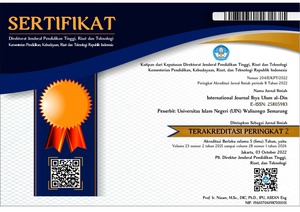Maqashid Syari’ah Menjawab Tantangan Post-Truth Era: Urgensi Hifẓ Al-‘Aql Sebagai Penyaring Informasi
DOI:
https://doi.org/10.21580/ihya.21.2.4831Keywords:
Ḥifẓ al-‘aql, Maqāṣid Syarī’ah, Post-truth EraAbstract
The development of information technology has an impact on the spread of false news, false data, and hate speech, which is difficult to control. Truth mixed with badness will be ambiguous and biased. This is the most visible symptom or symptom of the post-truth era. In this context, the concept of hifẓ al-‘aql in the maqāṣid syarī'ah can be used as a solution to deal with the negative symptoms above. This research is focused on how far the concept of hifẓ al-qaql can be used as an information filter. The data's research is library research. The data collection method uses the documentation method, which is: collecting, then analyzing the data collected. After that, data analysis is carried out by means of data reduction, presentation of data in narrative form, and concluding. This study concludes that the concept of hifẓ al-‘aql can be extended to mental and intellectual functions. The meaning of hifẓ al-‘aql is expanded by making reason as a guide, and controller for rationality (‘aqlaniyah). This expansion of meaning emphasizes that filtering information before it is conveyed to others is a must, and worthy of worship. Vice versa, the spread of news and hate speech received without verification is an action that is contrary to the principle of hifẓ al-qaql, prohibited acts, and has syar'i consequences.Downloads
References
Abu Zahrah, Muhammad. 1958. Ushul Al-Fiqh. Mesir: Dar al-Fikr al-‘Arabi.
Ad-Daraini, Fathi. 1975. Al-Manahij Al-Ushuliyyaah Fi Ijtihad Bi Ar-Ra’yi Fi at-Tasyri’. Damaskus: Dar al-Kitab al-Hadis.
Al-Farahidi, Abu Abdirrahman al Khalil bin Ahmad. Kitab Al-‘Ayn. eds. Mahdi Al-Makhzumi and Ibrahim As-Samira’i. Dar wa Maktabah al Hilal.
Al-Ghazali, Abu Hamid Muhammad. 1983. Al-Mustashfa Min ‘Ilm Al-Ushul. Beirut: Dar Al-Kutub Al-Ilmiyyah.
Al-Ghazali, Abu Hamid Muhammad bin Muhammad. 1996. Ilmu Dalam Perspektif Tasawuf Al-Ghazali. Translated by Muhammad Al-Baqir. Bandung: Karisma.
As-Syatibi, Abu Ishaq. 2003. Al-Muwafaqat Fi Usul as-Syariah. Beirut: Darl Kurub al- Ilmiyah.
Auda, J. 2008. Maqasid Al-Shariah as Philosophy of Islamic Law: A Systems Approach. International Institute of Islamic Thought. https://books.google.co.id/books?id=5sKQF16gdWgC.
Corlett, J. Angelo, and Robert Francescotti. 2003. Foundations of a Theory of Hate Speech. Wayne Law Review 48.
Habib, Bakr Ismail. 2003. Maqashid Syariah Ta’shilan Wa Taf’ilan. Dakwatul Haq.
Hallaq, Wael B, and Donald P. Litte. 1991. The Frimacy of The Qur’an in Syatibi Legal Theori. Leiden: EJ-Brill.
Handoyo, Eko. 2018. “Pancasila Pengokoh Integrasi Nasional Di Era Disrupsi: Sebuah Strategi Untuk Mengawal Mental Generasi Z.” UNNES Semarang.
Ibn Asyur, Thahir. 2005. Maqashid As-Syariah Al-Islamiyah. Kairo: Dar Salam.
Ibn Manzur, Muhammad Ibn Makram. 1958. Lisan Al-Arab. Beirut: Dar Sadir.
Maulidi. 2015. “Maqasid Syariah Sebagai Filsafat Hukum Islam: Sebuah Pendekatan Sistem Menurut Jasser Auda.” Al-Mazahib 3(No. 1 (June 2015)): 1–19.
Nata, Abuddin. 2004. Tafsir Ayat-Ayat Pendidikan. Jakarta: Raja Grafindo Persada.
Poerwadarminta, W.J.S. 2007. Kamus Umum Bahasa Indonesia. Jakarta: Balai Pustaka.
Qodir, Zuly. 2018. “Hibriditas Kultural Dan Radikalisme.” Kompas, April 11, 2018.
Rahardjo, M. Dawam. 2002. Ensiklopedi Al-Qur`an, Tafsir Sosial Berdasarkan Konsep-Konsep Kunci. Jakarta: Paramadina.
Rahman, Fazlur. 1984. Islam. Translated by Muhammad Ahsin. Bandung: Pustaka.
Syuhada, Kharisma Dhimas. 2017. ““Etika Media Di Era “Post-Truth.” Jurnal Komunikasi Indonesia VI, no. 1: 75–79.
Tim Redaksi. 2005. Kamus Besar Bahasa Indonesia. III. Jakarta: Balai Pustaka.
Wehr, Hans, and J. Milton Coan. 1980. A Dictionary of Modern Written Arabic. London: Macdonal and Evans LTD. https://books.google.co.id/books?id=WTak55pG-_IC.
Zuhaili, Wahbah. 2000. Taghayyur Al-Ijtihad. Damaskus: Dar al-Maktabi.
Downloads
Published
How to Cite
Issue
Section
License
By submitting an article to the journal, the author(s) agree to transfer the published article's copyright to the journal, which will act as the publisher. This means the journal will have the right to publish the article in various forms, including reprints. The journal will maintain the publishing rights to the published articles.
This work is licensed under Creative Commons Attribution-ShareAlike 4.0 International License.
In line with the license, authors and third parties (readers, researchers, and others) are allowed to share and adapt the material. In addition, the material must be given appropriate credit, provided with a link to the license, and indicated if changes were made. If authors remix, transform or build upon the material, authors must distribute their contributions under the same license as the original.



